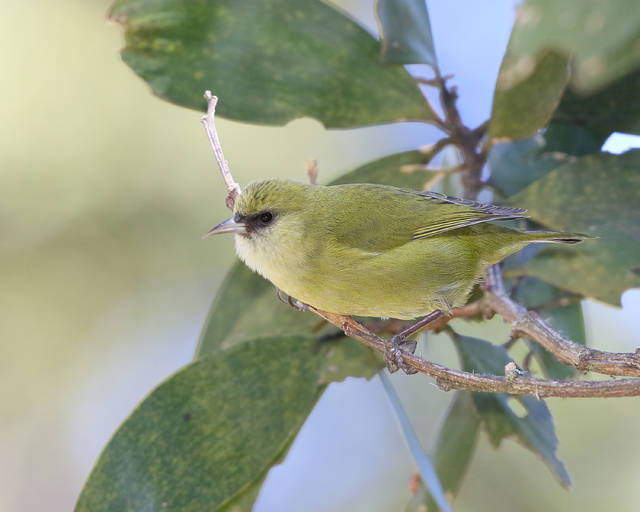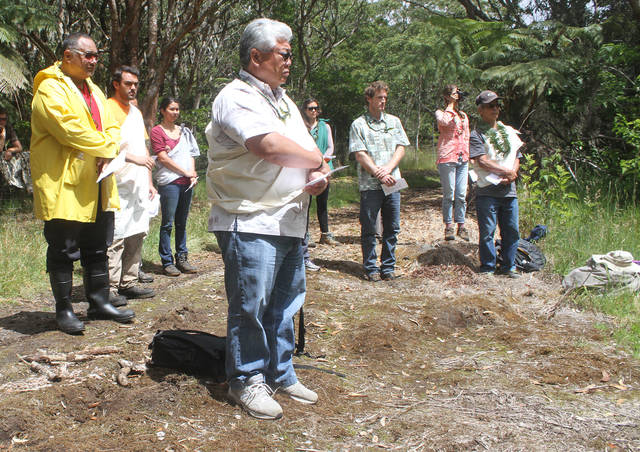For more than a century, a small native forest bird went without its Hawaiian name.
For more than a century, a small native forest bird went without its Hawaiian name.
In nature guides, it stands out for its Western moniker — Hawaii creeper — but in most other ways the little bird is somewhat plain.
A drab yellow-green-gray, it doesn’t have flashy colors like the akepa or the apapane. Its beak is a standard beak — no striking curved bill like the iiwi and the akiapolaau. It’s often confused for the amakihi, but unlike its fellow honeycreeper prefers to live in koa trees and forage for insects.
“It’s not a super conspicuous bird,” said Alex Wang of the Department of Land and Natural Resources’ Natural Area Reserves System. “It doesn’t get as much attention.”
The little bird is endangered. It is one of four forest bird species that is found only on Hawaii Island.
“It needs a lot of help,” said Noah Gomes, a park ranger at Hawaii Volcanoes National Park and cultural practitioner.
On Wednesday, Gomes and Wang joined a group of 25 conservation managers, cultural practictioners and government representatives in the Kulani tract of the Pu‘u Maka‘ala Natural Area Reserve for a ceremony to offer the bird a boost: its traditional name, rediscovered after decades.
Gomes came across evidence for the name while working on his master’s thesis at the University of Hawaii at Hilo. The thesis discussed ancient Hawaiian birdcatchers.
And while Gomes was doing research, an unfamiliar name appeared over and over: ‘alawi. Some sources offered descriptions of the bird, which was yellow-green-gray and lived in koa forests.
“There was just enough that I thought, ‘You know what, this bird sounds a lot like the Hawaii creeper,’” Gomes said.
Gomes translated, among other sources, a bird guide that appeared in an 1863 edition of the Hawaiian language newspaper Ka Nupepa Kuokoa, and an interview by Hawaii archivist Nathaniel Emerson. The name ‘alawi even appears in the Kumulipo, the Hawaiian genealogical chant about the birth of the universe.
“The descriptions of the color, the beak, that seemed like the only logical choice,” Gomes said. ‘Alawi also corresponded to similar names of creepers on other islands, like Lanai’s lauwi.
The Department of Land and Natural Resources called Gomes’ evidence “unusually good,” noting in a release that “there are not many other possible candidates that match the identity of a conspicuous small grayish green forest bird currently lacking a known Hawaiian name.”
‘Alawi was officially approved in February by the Hawaii Lexicon Committee as the name for the little bird. Wednesday’s naming ceremony was the first step in “bringing the (‘alawi) out of the darkness,” Gomes said.
“The alawi has been overlooked for most of the last century,” Wang said. Knowing more about the bird helps gain a better understanding of the health of the koa forest itself. If there is a healthy population of ‘alawi, the forest is healthy, too.
“Arguably, this (the Kulani tract at Pu‘u Maka‘ala) is one of the highest quality forests on the islands,” said Nick Agorastos, a Natural Area Reserves Specialist in the DLNR’s Division of Forestry and Wildlife. “The parts and pieces are here, the birds are still moving around around. Much of the ecosystem is still left here.”
Pu‘u Maka‘ala is also the release site for an effort to restore populations of ‘alala, or Hawaiian crow, which is extinct in the wild.
Emma Yuen of DOFAW’s Native Ecosystems Protection and Management Program said that holding the ‘alawi naming ceremony in a stand of intact forest was an important way to strengthen Hawaiian culture. Because they are considered the best examples of native ecosystems, Natural Area Reserves offer a way for visitors to step back in time.
“A lot of folks want to know what it was like when ancient Hawaiians were first here,” Yuen said.
Before the ceremony began, the group stood to listen to calls from the treetops. Wang identified them one by one. An apapane calling from high in the treetops. An omao. An elepaio, an akiapolau, a possible iiwi.
And somewhere in the koa, Wang said, a young ‘alawi calling for its mother to bring it food.


